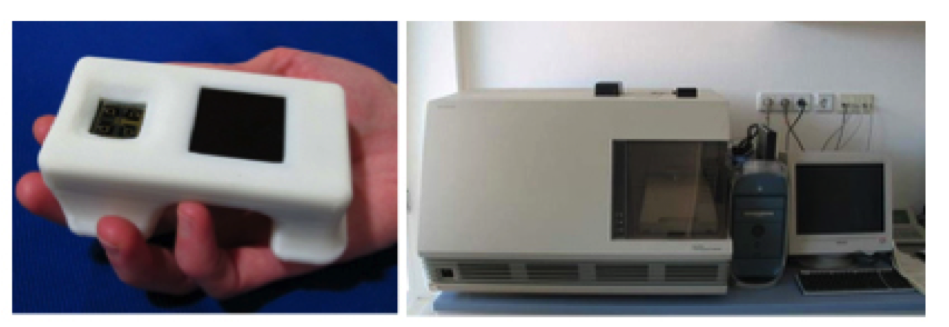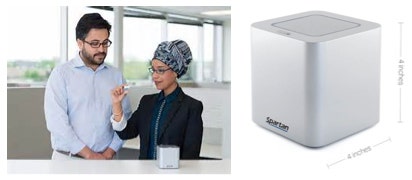- Records Are Meant to be Broken—Including Those for PCR Diagnostics
- Spartan Bioscience Claims It’s Cube is World’s Smallest Mol Dx Device
- The Cube was Launched at the Recent AACC Clinical Lab Expo
Prologue
 [22>
[22>
-annulene. Taken from Wikipedia.com
-annulene with n=22 (see below) synthesized by F. Sondheimer. But I digress…
Our collective fascination with records—and beating them—also applies to all sorts of instruments for health-related sciences, such as the most powerful MRI imaging systems (currently from GE) or longest-DNA-sequencing system (currently from PacBio). Due to the seemingly endless utility of PCR, there is a continual stream of claims for the fastest PCR system (currently from BJS Biotechnologies) or—more to point herein—smallest PCR system.
To wit, regular readers of my blog will recall an April 2016 post titled World’s Smallest Real-Time PCR Device, which referred to a hand-held system reported by Ahrberg et al. for real-time, quantitative PCR (qPCR). That system is pictured below next to the original system commercialized by ABI in the 1990s that weighed 350 pounds and was 7 feet long!
 Left: World’s smallest real-time PCR device. (Taken from Ahrberg et al). Right: Applied Biosystems 7700 real-time PCR system. (Taken from distrobio.com).
Left: World’s smallest real-time PCR device. (Taken from Ahrberg et al). Right: Applied Biosystems 7700 real-time PCR system. (Taken from distrobio.com).
It seems that PCR records fall as easily as those in the Olympics. Not even a year later, Ahrberg’s claim is being challenged by Canadian company Spartan Bioscience, which recently introduced its Cube device at the 2016 AACC Annual Scientific Meeting & Clinical Lab Expo. Following are some technical details that I thought were worth sharing.
 Taken from businessinsider.com
Taken from businessinsider.com
Cube Facts
Given its amazingly small size of only 4 x 4 x 4 inches, there apparently has been some remarkable engineering achievements to be able to squeeze-in what’s needed for the rapid heating and cooling required for PCR thermal cycling. Ditto for the optics required to enable fluorescence detection. Like other relatively small devices intended for emerging Point-of-Care (POC) applications in a doctor’s office or clinic, there is wireless connectivity to a laptop that serves as the user interface for operation and data analysis, as well as a power source for the Cube via a USB cable.
You’re likely wondering by now how much the Cube will sell for. Unfortunately, I was not able to obtain a list price from Spartan’s CEO at this time, so we’ll all have to wait and see. I’ll post the answer as a comment to this blog as soon as I find out the price.
Inside the Cube—Perhaps
I actually don’t know exactly what’s inside the Cube, but some possibilities of what might be are as follows. I’ve based these educated guesses on a Spartan Bioscience patent (US pat. no. 8,945,880) by Paul Lem and others entitled Thermal cycling by positioning relative to fixed-temperature heat source. As depicted below, a hot block provides a heat source at a fixed temperature to thermally cycle PCR reaction vessels that can be precisely moved by a micrometer to and from the hot block in a repeated manner.

As for how fluorescence might be measured to monitor each PCR reaction in real-time, one possibility is depicted below. Basically, each reaction tube is proximate to excitation light from an LED, and has a slit at the bottom for emitted light that is collected and processed into a typical real-time PCR curve.

Before the Cube
Prior to launching the Cube, Spartan Bioscience has been selling an FDA-Cleared in vitro diagnostic product called Spartan RX, which is also relatively compact, and carries out fully automated—“cheek swab-to-result”—PCR analysis of certain Cytochrome P450 2C19 (CYP2C19) genotypes. Roughly 1-in-3 people carry CYP2C19 mutations that can impair metabolism of a wide variety of commonly used drugs. Consequently, these PCR-based results are a valuable aid to clinicians in determining strategies for therapeutics that are metabolized by the Cytochrome P450 2C19.
I was favorably impressed by the fact that this CYP2C19 assay qualifies for reimbursement from Medicare and most insurers, according to the company’s website, which adds that there is an ongoing 6,000-patient clinical trial entitled Tailored Antiplatelet Initiation to Lessen Outcomes due to Clopidogrel Resistance after Percutaneous Coronary Interventions (TAILOR PCI).
The Spartan RX cheek swab POC results have been recently compared to centralized genotyping with a TaqMan® allelic discrimination assay (Life Technologies) using qPCR and with the GenID® reverse dot-blot hybridization assay (Autoimmun Diagnostika GmbH). Published results indicate excellent agreement, and led to the following conclusions by the authors: “Compared to both laboratory-based genotyping assays, the POC assay is accurate and reliable, provides rapid results, can process single samples, is portable and more operator-friendly, however the tests are more expensive.”
I look forward to finding out more about the Cube and the PCR results it can obtain. I’ll post more information on my blog as it becomes available. As usual, your comments are welcomed.
Postscript
To me, there’s something visually intriguing about a cube, perhaps because it’s one of the so-called Platonic Solids, which have been known since antiquity and studied extensively by the ancient Greeks.

Platonic solids such as the cube have also fascinated chemists, as evidenced by there being a substantial amount of published literature on the synthesis and physical properties of platonic solids. For example, cubane (C8H8) is a synthetic hydrocarbon molecule that consists of eight carbon atoms arranged at the corners of a cube, with one hydrogen atom attached to each carbon atom. A solid crystalline substance, cubane was first synthesized in 1964 by Philip Eaton and Thomas Cole. Prior to this work, researchers believed that cubic carbon-based molecules would be too unstable to exist.

On the fun side, the cube was morphed—so to speak—into what became an amazingly popular game, or should I say, object of competition. Rubik's Cube is a 3-D combination puzzle invented in 1974 by Hungarian sculptor and professor of architecture Ernő Rubik. If you’re wondering about the world’s record for solving this puzzle, it’s currently a mind-boggling 4.9 sec, according to a list (with video links) of this and past records that appear to have been broken regularly, just as I opined at the beginning of this blog. But I digress…yet again.






